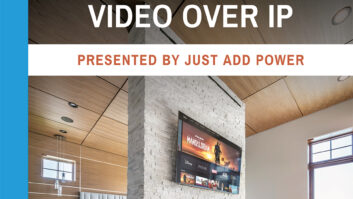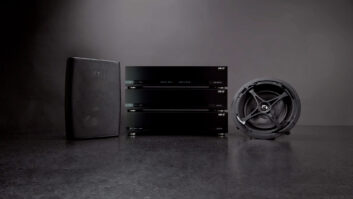Like so many other aspects of AV technology, video distribution is changing. And Eddie Shapiro’s approach is evolving along with it.

“Back in the day, with chassis-based systems, we slid cards into the chassis to handle sources such as Apple TV, cable boxes, and Blu-ray players, says Shapiro, founder, SmartTouchUSA. “We are a Crestron Platinum dealer, and we have a heavy focus on digital media and video over IP.”
The first step is to explain to potential video distribution clients that they can use one source, such as a cable box, and display that source on multiple video displays. “Rather than eight cable boxes, one or two can be shared, for example,” Shapiro says. “These sources can be shared on all video displays, or selectively to several, or at the same time.”
With varying client needs and preferences, manufacturers are offering video matrix units in an array of sizes. “When using a chassis-based system, you can often configure those systems such as 4×4, 8×8, 16×16, and 32×32. Crestron even has a chassis system that can support a 128×128 configuration, but a system of this size is often used in commercial settings or on large yachts,” he notes. “In the residential world, the typical system is a 4×4 up to 16×16 solution, with four or more sources that can include a number of cable boxes, Apple TV units, Roku, and Kaleidescape players.”
It’s a network game
Rather than a dedicated video matrix unit, video is now being distributed over the network. “It looks like video over IP is here to stay, and every manufacturer is offering it,” Shapiro says. “We use Crestron’s DM NVX platform for video over IP at our new Experience Center, and on most new system installations. Crestron has always delivered excellent 4K quality with their Digital Media platform, and NVX is no exception.”
NVX, he states, delivers 4K60 4:4:4 HDR video, and the switching between sources is incredibly quick. “In a video-over-IP scenario, each source and each display has an endpoint. Video over IP is very flexible, which means that you can set up sources and displays in almost any configuration. For example, you could have four sources and ten displays, and each device would have their own endpoint or video-over-IP module. This means, in this example, that there would be 14 endpoints.
“From a hardware perspective, the biggest difference between a typical video matrix and video over IP is the network. A traditional video matrix chassis does all of the switching, but, in the world of video over IP, the endpoints and software handle the switching, and all traffic for video distribution is being handled by a network switch.”
Instead of a chassis in the rack for the entire distribution system, the system can feature four sources in the rack with the actual NVX modules behind each display or in the same room as the display, creating a decentralized video matrix solution. “Video distribution has evolved from the video matrix chassis in the rack to a solution with endpoints out in the field. By taking the video matrix out of the AV rack, video distribution is now incredibly flexible, with the sources and displays distributing excellent 4K video over carefully engineered networks. There are lots of benefits to a decentralized system, including less equipment in the AV rack in many cases.”
Some systems, such as NVX, are so flexible, you can have an Apple TV or Roku device at a video display, maybe in the family room, and use the endpoint at that display to share the streaming devices content over the network to other video over IP endpoints or rooms, Shapiro continues. “Another advantage of the video over IP platform is expandability. As long as you have space on your network switch and a category cable in the room being added to the system, you can keep adding video displays or sources to your overall video distribution system.”
Video over IP is what clients want, although they need to be educated on the capabilities it affords. “It’s incredibly flexible and scales nicely,” he says. “All the residential control companies and video component manufacturers seem to be offering some type of video-over-IP solution. Price and performance definitely vary. Dealers should stick to what they know, but be sure that the specifications your favorite brand is publishing is the spec they are actually delivering.”

Depending on the brand, dealers can go back to clients who want to add 4K, Shapiro suggests. “Currently, we’re working with a client who has an existing Crestron DM video matrix and wants to upgrade some displays to 4K. We’re upgrading his eight-year-old system by creating a hybrid system of sorts by adding six 4K video displays and 4K sources with Crestron NVX 4K endpoints. With some changes to the touch displays and foundation code, the client will have 4K viewing in rooms that are used the most. For the larger systems, upgrading to 4K with video over IP is a flexible solution.”
Also read: The Integration Guide to Projectors and Screens
The biggest challenge today with this new type of video distribution is that everything lives on the network, and it’s essential to understand how the network works, he concludes. “Visualize four endpoint modules plugged into the network switch and four or more other endpoints connected to video displays, all talking through the network switch, so all video traffic passes through that switch. It’s a good way to understand how vastly different this is from a video matrix using the older chassis technology.
“If you don’t know networks, you will struggle with video over IP. It’s crucial to know how to configure a network for this type of video traffic and system architecture. Most good manufacturers should be able to help get you up to speed.”







